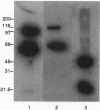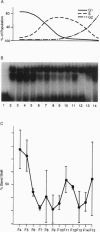Abstract
We describe a novel DNA damage binding activity in nuclear extracts from a normal human fibroblast cell strain. This protein was identified using electrophoretic mobility shift assays of immunopurified UV-irradiated oligonucleotide substrates containing a single, site-specific cyclobutane pyrimidine dimer or a pyrimidine (6-4) pyrimidinone photoproduct. Compared with the (6-4) photoproduct, which displayed similar levels of binding in double and single-stranded substrates, the protein showed somewhat lower affinity for the cyclobutane dimer in a single-stranded oligonucleotide and negligible binding in double-stranded DNA. The specificity and magnitude of binding was similar in cells with normal excision repair (GM637) and repair-deficient cells from xeroderma pigmentosum groups A (XP12RO) and E (XP2RO). An apparent molecular mass of 66 kDa consisting of two subunits of approximately 22 and approximately 44 kDa was determined by Southwestern analysis. Cell cycle studies using centrifugal cell elutriation indicated that the binding activity was significantly greater in G1 phase compared with S phase in a human lymphoblast cell line. Gel supershift analysis using an anti-replication protein A antibody showed that the binding protein was not antigenically related to the human single-stranded binding protein. Taken together, these data suggest that this activity represents a novel DNA damage binding protein that, in addition to a putative role in excision repair, may also function in cell cycle or gene regulation.
Full text
PDF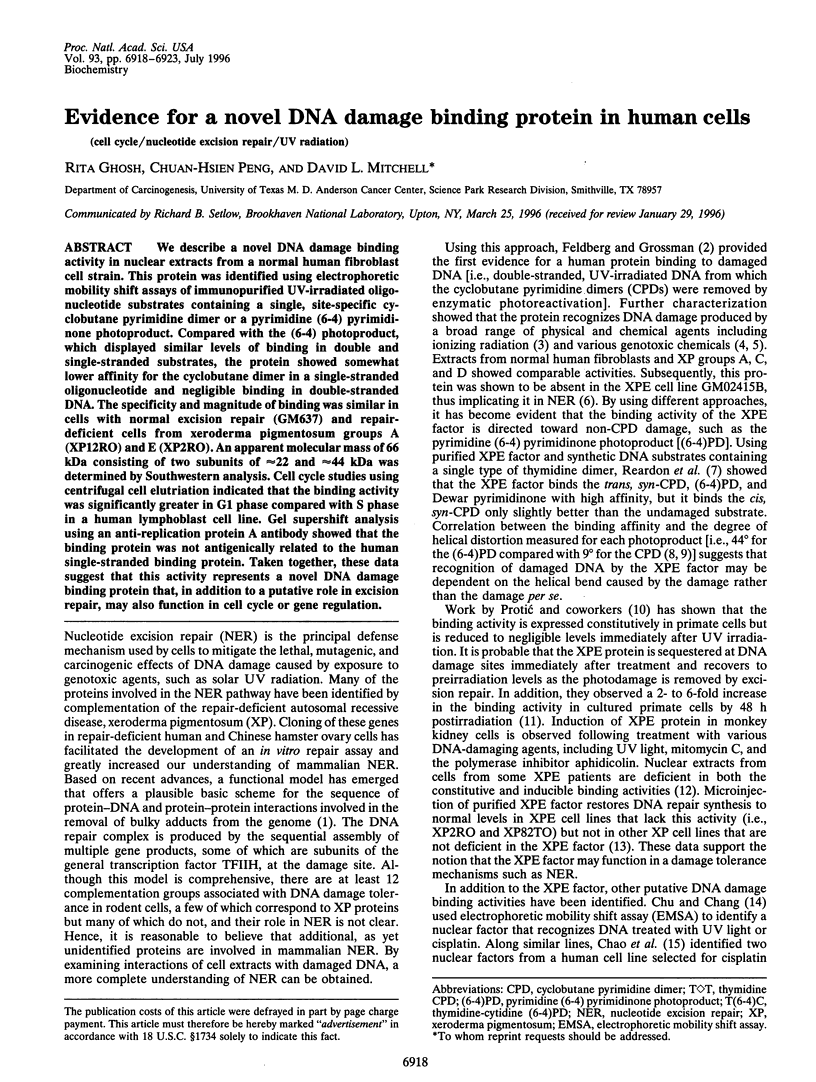
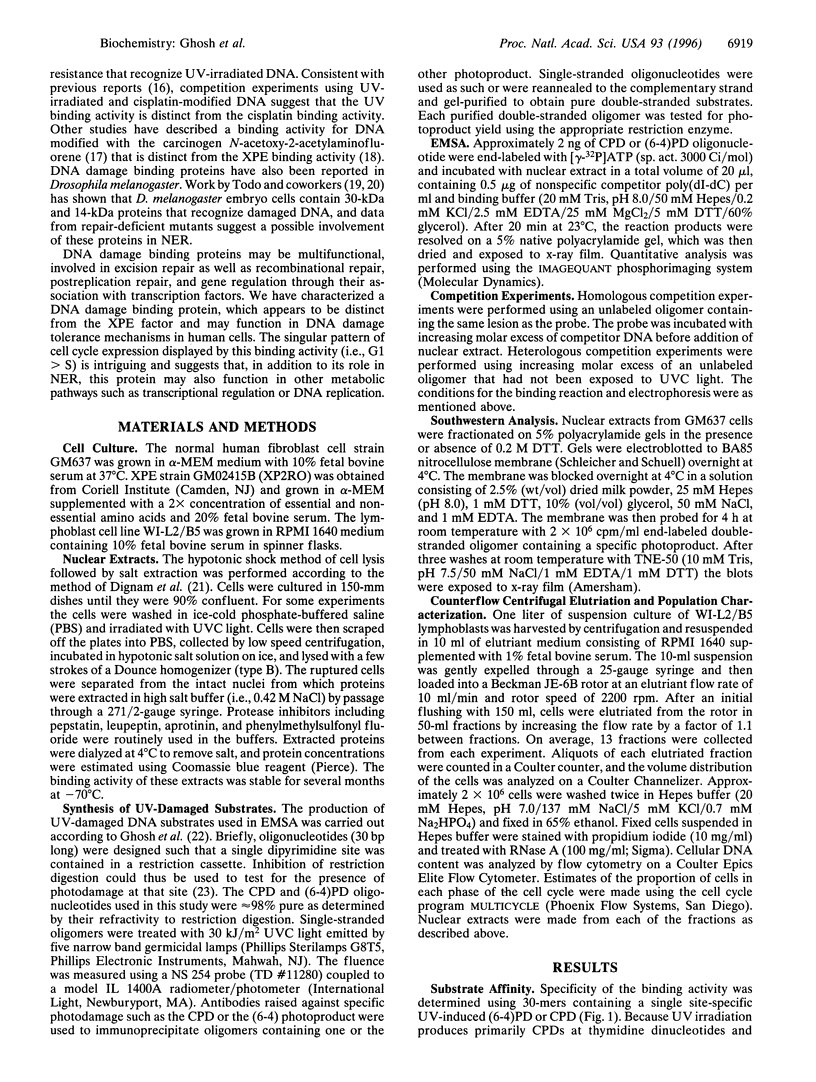
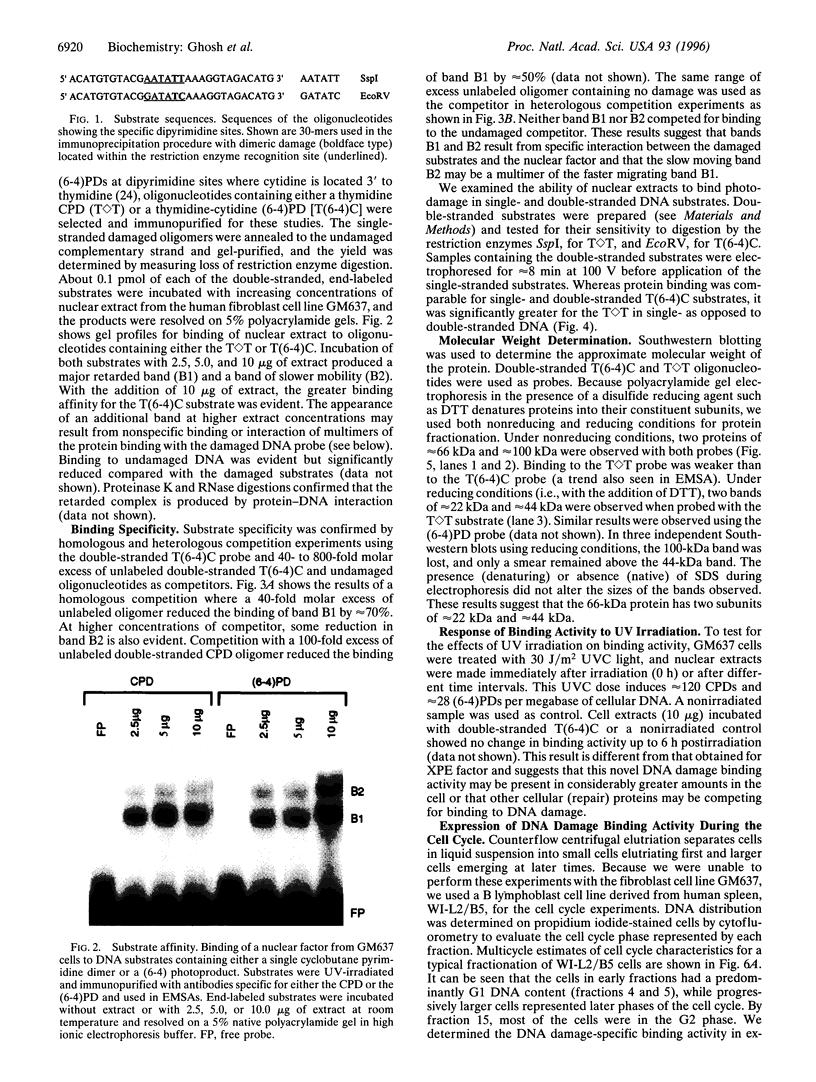
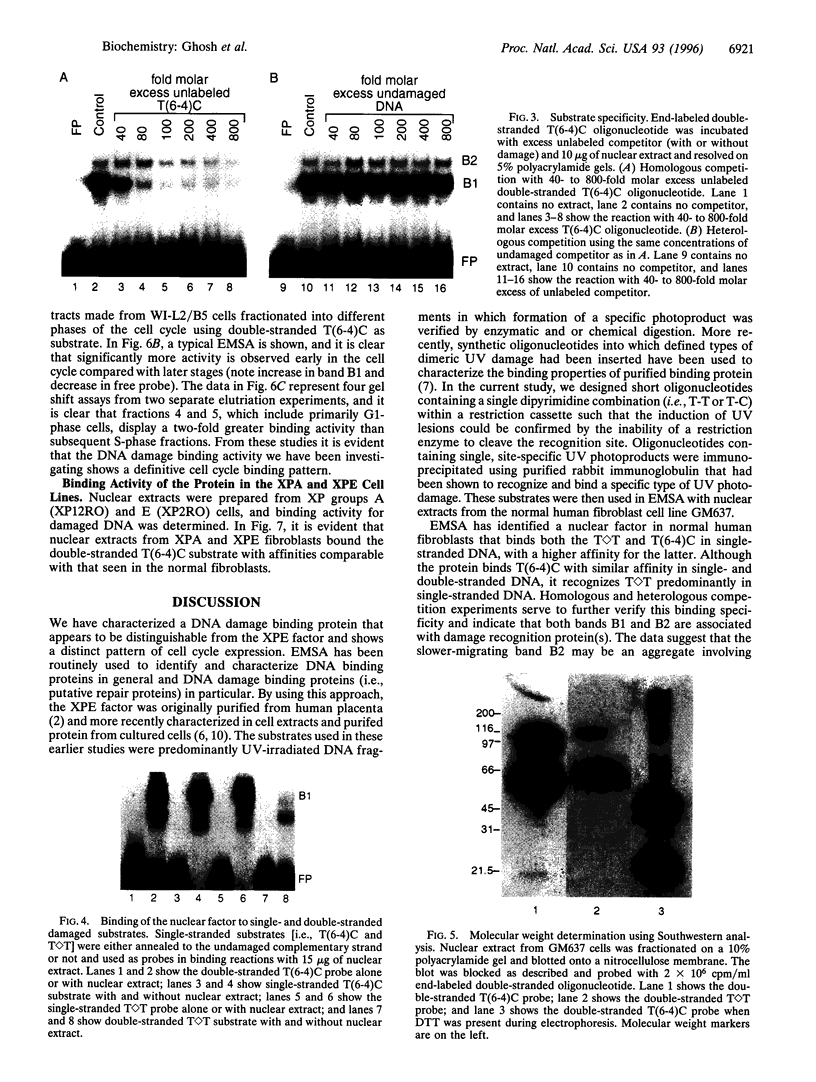

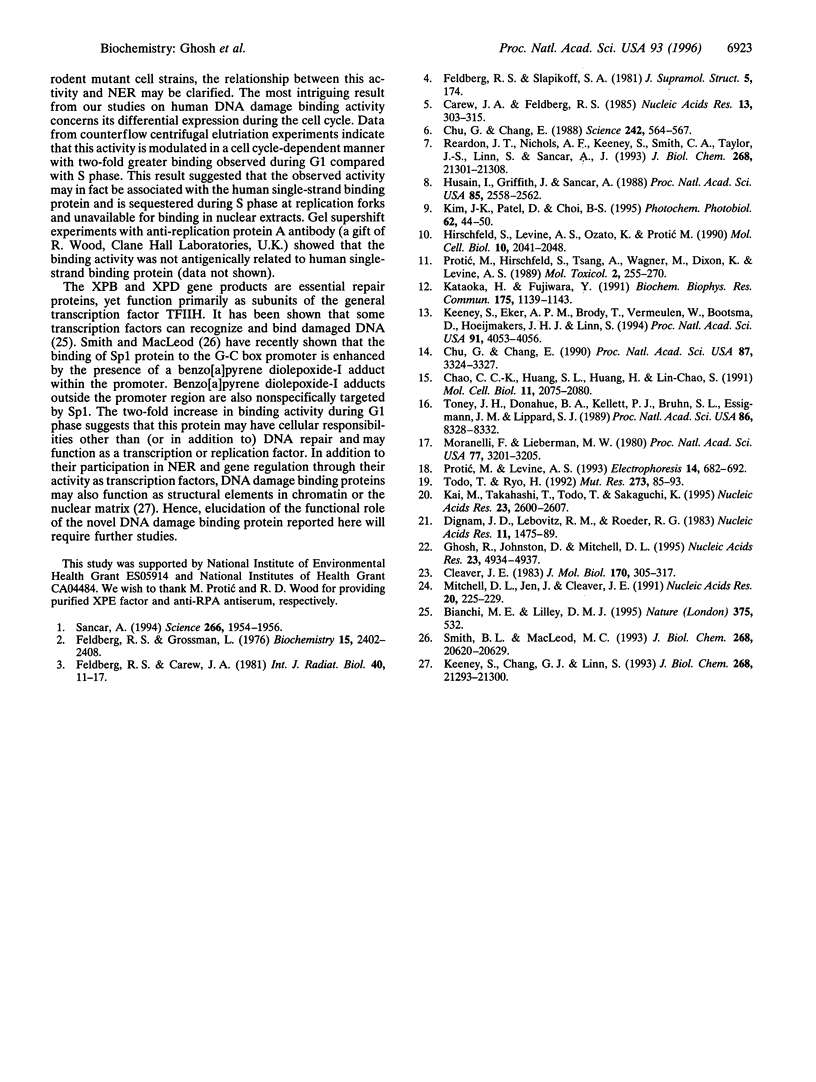
Images in this article
Selected References
These references are in PubMed. This may not be the complete list of references from this article.
- Bianchi M. E., Lilley D. M. Applying a genetic cantilever. Nature. 1995 Jun 15;375(6532):532–532. doi: 10.1038/375532a0. [DOI] [PubMed] [Google Scholar]
- Carew J. A., Feldberg R. S. Recognition of a cytosine base lesion by a human damage-specific DNA binding protein. Nucleic Acids Res. 1985 Jan 11;13(1):303–315. doi: 10.1093/nar/13.1.303. [DOI] [PMC free article] [PubMed] [Google Scholar]
- Chao C. C., Huang S. L., Huang H. M., Lin-Chao S. Cross-resistance to UV radiation of a cisplatin-resistant human cell line: overexpression of cellular factors that recognize UV-modified DNA. Mol Cell Biol. 1991 Apr;11(4):2075–2080. doi: 10.1128/mcb.11.4.2075. [DOI] [PMC free article] [PubMed] [Google Scholar]
- Chu G., Chang E. Cisplatin-resistant cells express increased levels of a factor that recognizes damaged DNA. Proc Natl Acad Sci U S A. 1990 May;87(9):3324–3327. doi: 10.1073/pnas.87.9.3324. [DOI] [PMC free article] [PubMed] [Google Scholar]
- Chu G., Chang E. Xeroderma pigmentosum group E cells lack a nuclear factor that binds to damaged DNA. Science. 1988 Oct 28;242(4878):564–567. doi: 10.1126/science.3175673. [DOI] [PubMed] [Google Scholar]
- Cleaver J. E. Restriction enzyme cleavage of ultraviolet-damaged simian virus 40 and pBR322 DNA. J Mol Biol. 1983 Oct 25;170(2):305–317. doi: 10.1016/s0022-2836(83)80150-8. [DOI] [PubMed] [Google Scholar]
- Dignam J. D., Lebovitz R. M., Roeder R. G. Accurate transcription initiation by RNA polymerase II in a soluble extract from isolated mammalian nuclei. Nucleic Acids Res. 1983 Mar 11;11(5):1475–1489. doi: 10.1093/nar/11.5.1475. [DOI] [PMC free article] [PubMed] [Google Scholar]
- Feldberg R. S., Carew J. A. Water radiolysis products and nucleotide damage in gamma-irradiated DNA. Int J Radiat Biol Relat Stud Phys Chem Med. 1981 Jul;40(1):11–17. [PubMed] [Google Scholar]
- Feldberg R. S., Grossman L. A DNA binding protein from human placenta specific for ultraviolet damaged DNA. Biochemistry. 1976 Jun 1;15(11):2402–2408. doi: 10.1021/bi00656a024. [DOI] [PubMed] [Google Scholar]
- Ghosh R., Johnston D. A., Mitchell D. L. Generation of oligonucleotides containing site-specific cyclobutane pyrimidine dimers and pyrimidine(6-4)pyrimidinone photoproducts by immunoprecipitation. Nucleic Acids Res. 1995 Dec 11;23(23):4934–4937. doi: 10.1093/nar/23.23.4934. [DOI] [PMC free article] [PubMed] [Google Scholar]
- Hirschfeld S., Levine A. S., Ozato K., Protić M. A constitutive damage-specific DNA-binding protein is synthesized at higher levels in UV-irradiated primate cells. Mol Cell Biol. 1990 May;10(5):2041–2048. doi: 10.1128/mcb.10.5.2041. [DOI] [PMC free article] [PubMed] [Google Scholar]
- Husain I., Griffith J., Sancar A. Thymine dimers bend DNA. Proc Natl Acad Sci U S A. 1988 Apr;85(8):2558–2562. doi: 10.1073/pnas.85.8.2558. [DOI] [PMC free article] [PubMed] [Google Scholar]
- Kai M., Takahashi T., Todo T., Sakaguchi K. Novel DNA binding proteins highly specific to UV-damaged DNA sequences from embryos of Drosophila melanogaster. Nucleic Acids Res. 1995 Jul 25;23(14):2600–2607. doi: 10.1093/nar/23.14.2600. [DOI] [PMC free article] [PubMed] [Google Scholar]
- Kataoka H., Fujiwara Y. UV damage-specific DNA-binding protein in xeroderma pigmentosum complementation group E. Biochem Biophys Res Commun. 1991 Mar 29;175(3):1139–1143. doi: 10.1016/0006-291x(91)91684-5. [DOI] [PubMed] [Google Scholar]
- Keeney S., Chang G. J., Linn S. Characterization of a human DNA damage binding protein implicated in xeroderma pigmentosum E. J Biol Chem. 1993 Oct 5;268(28):21293–21300. [PubMed] [Google Scholar]
- Keeney S., Eker A. P., Brody T., Vermeulen W., Bootsma D., Hoeijmakers J. H., Linn S. Correction of the DNA repair defect in xeroderma pigmentosum group E by injection of a DNA damage-binding protein. Proc Natl Acad Sci U S A. 1994 Apr 26;91(9):4053–4056. doi: 10.1073/pnas.91.9.4053. [DOI] [PMC free article] [PubMed] [Google Scholar]
- Kim J. K., Patel D., Choi B. S. Contrasting structural impacts induced by cis-syn cyclobutane dimer and (6-4) adduct in DNA duplex decamers: implication in mutagenesis and repair activity. Photochem Photobiol. 1995 Jul;62(1):44–50. doi: 10.1111/j.1751-1097.1995.tb05236.x. [DOI] [PubMed] [Google Scholar]
- Mitchell D. L., Jen J., Cleaver J. E. Sequence specificity of cyclobutane pyrimidine dimers in DNA treated with solar (ultraviolet B) radiation. Nucleic Acids Res. 1992 Jan 25;20(2):225–229. doi: 10.1093/nar/20.2.225. [DOI] [PMC free article] [PubMed] [Google Scholar]
- Moranelli F., Lieberman M. W. Recognition of chemical carcinogen-modified DNA by a DNA-binding protein. Proc Natl Acad Sci U S A. 1980 Jun;77(6):3201–3205. doi: 10.1073/pnas.77.6.3201. [DOI] [PMC free article] [PubMed] [Google Scholar]
- Protić M., Hirschfeld S., Tsang A. P., Wagner M., Dixon K., Levine A. S. Induction of a novel damage-specific DNA binding protein correlates with enhanced DNA repair in primate cells. Mol Toxicol. 1989 Oct-Dec;2(4):255–270. [PubMed] [Google Scholar]
- Protić M., Levine A. S. Detection of DNA damage-recognition proteins using the band-shift assay and southwestern hybridization. Electrophoresis. 1993 Aug;14(8):682–692. doi: 10.1002/elps.11501401109. [DOI] [PubMed] [Google Scholar]
- Reardon J. T., Nichols A. F., Keeney S., Smith C. A., Taylor J. S., Linn S., Sancar A. Comparative analysis of binding of human damaged DNA-binding protein (XPE) and Escherichia coli damage recognition protein (UvrA) to the major ultraviolet photoproducts: T[c,s]T, T[t,s]T, T[6-4]T, and T[Dewar]T. J Biol Chem. 1993 Oct 5;268(28):21301–21308. [PubMed] [Google Scholar]
- Sancar A. Mechanisms of DNA excision repair. Science. 1994 Dec 23;266(5193):1954–1956. doi: 10.1126/science.7801120. [DOI] [PubMed] [Google Scholar]
- Smith B. L., MacLeod M. C. Covalent binding of the carcinogen benzo[a]pyrene diol epoxide to Xenopus laevis 5 S DNA reconstituted into nucleosomes. J Biol Chem. 1993 Sep 25;268(27):20620–20629. [PubMed] [Google Scholar]
- Todo T., Ryo H. Identification of cellular factors that recognize UV-damaged DNA in Drosophila melanogaster. Mutat Res. 1992 Jan;273(1):85–93. doi: 10.1016/0921-8777(92)90052-5. [DOI] [PubMed] [Google Scholar]
- Toney J. H., Donahue B. A., Kellett P. J., Bruhn S. L., Essigmann J. M., Lippard S. J. Isolation of cDNAs encoding a human protein that binds selectively to DNA modified by the anticancer drug cis-diamminedichloroplatinum(II) Proc Natl Acad Sci U S A. 1989 Nov;86(21):8328–8332. doi: 10.1073/pnas.86.21.8328. [DOI] [PMC free article] [PubMed] [Google Scholar]






